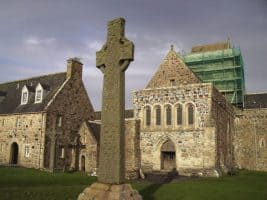
St. Columba’s Work on the Isle of Iona
When Columba traveled from Ireland to Scotland, he brought the gospel with him. On this episode of 5 Minutes in Church History, Dr. Stephen Nichols introduces us to this missionary, scribe, and hymn writer.
On this episode, let’s go to a place in church history: to the beautiful Isle of Iona. Iona is on the west coast of Scotland, roughly sixty miles north of Northern Ireland. St. Columba, who is credited with bringing Christianity to Scotland, died there on the Isle of Iona on June 9, 597.
We had talked about Columba on a previous episode when we had our good friend Sinclair Ferguson here talking about his book In the Year of Our Lord. We talked about the two missionaries that brought Christianity to Scotland, so I thought we’d go back and spend a little bit of time at a specific place at Iona.
Columba was from the County Donegal in Ireland. In 563, Columba went to Scotland, and there on this Isle of Iona he established a monastery. From there, groups of monks spread out over these islands. These islands are an archipelago off the west coast of Scotland known as the Hebrides. There are the Outer Hebrides and the Inner Hebrides. Of course, the Inner Hebrides are closer to the mainland of Scotland. These are postcard picture-perfect islands, and one of the most beautiful of them is Iona.
The Abbey was established there in the 500s. All that stands today is a bank of earth that is a testament to that Abbey that Columba built. There’s also a ditch, and along that ditch at one time ran a wall. The current Abbey building is a thirteenth to sixteenth-century building added upon and developed over those centuries. It is thought that the Book of Kells was written there at Iona. In addition to being a missionary, preaching, and administering all these monks and monasteries that were established, Columba also was quite a scribe himself. It is said that he had transcribed over three hundred books personally. From that little monastery there at Iona, there was quite a library and a preservation of great classic texts.
 Iona is also a place of much rich stone architecture. There’s the famous St. Martin’s Cross. It’s one of four large crosses that originally stood there on Iona. This one was made from a single slab of marble sometime around 800. It stands on its plinth made of pink granite, and it has stood there since 800.
Iona is also a place of much rich stone architecture. There’s the famous St. Martin’s Cross. It’s one of four large crosses that originally stood there on Iona. This one was made from a single slab of marble sometime around 800. It stands on its plinth made of pink granite, and it has stood there since 800.
It has a shorter, not-quite proportionate crossbeam, and it is understood that some sort of metal or wooden structures would have extended out of the side of it. Many Scottish kings are buried in the churchyard at Iona, and it is also a place where not only Columba lived and died but also a place where he wrote some hymns. One of his hymns is this, “Christ is the World’s Redeemer:”
Christ is the world’s Redeemer,
The lover of the pure,
The font of heavenly wisdom,
Our trust and hope secure,
The armor of His soldiers,
The Lord of earth and sky,
Our health while we are living,
Our life when we shall die.Christ has our host surrounded
With clouds of martyrs bright,
Who wave their palms in triumph,
And fire us for the fight.
This Christ the cross ascended
To save a world undone
And, suffering for the sinful,
Our full redemption won.
Well, that’s Columba’s hymn written there on that beautiful Isle of Iona in the Hebrides off the western coast of Scotland.
Stay connected with 5 Minutes in Church History by getting the weekly podcast on iTunes, SoundCloud, or via RSS. You can also subscribe to the blog via RSS and follow us on Twitter and Facebook.
(This podcast is by Ligonier Ministries. Discovered by Christian Podcast Central and our community — copyright is owned by the publisher, not Christian Podcast Central, and audio is streamed directly from their servers.)